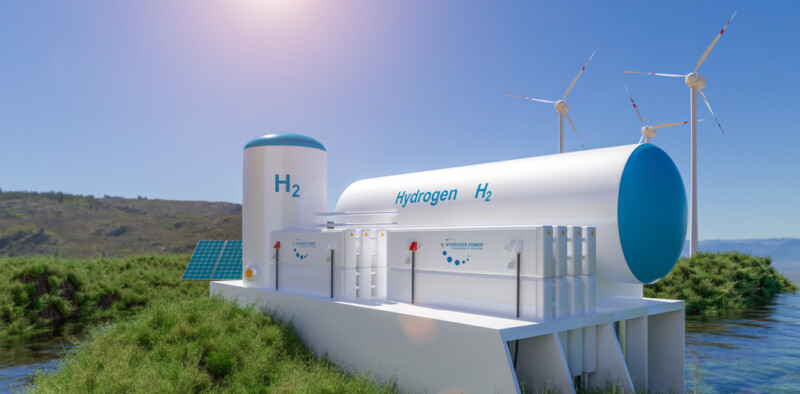China has recognized hydrogen as "a crucial element of the nation's future energy system" in its first-ever national hydrogen development plan launched in March, focused largely on lowering costs for green hydrogen and building up domestic capacity.

China is the latest country to set out a long-term hydrogen strategy. As of 2021, 17 governments had released hydrogen strategies and more than 20 governments had publicly announced plans to develop strategies, according to the International Energy Agency.
Data from state-backed think tank China Hydrogen Alliance or CHA suggests that the country's hydrogen roadmap heavily emphasizes building out a domestic supply chain, from manufacturing electrolyzers to generating end-user demand, with less importance given to hydrogen imports.
This implies a prioritizing of self-sufficiency and creation of a local industry for the emerging fuel source. However, the sheer scale of China's energy demand means that its hydrogen plan will add significantly to the global green hydrogen capacity build-out and cost reduction targets.
For instance, global installed electrolysis capacity could reach 54‑91 GW by 2030, and the cost of producing hydrogen from renewables is expected to fall as low as $1.30-$3.50/kg by 2030 in regions with abundant renewable resources, according to the IEA.
The CHA expects the production cost of green hydrogen, including capex, to fall below Yuan 25/kg or around $4/kg in China by 2025 and $2.40/kg by 2030, and electrolyzer capacity to reach 80 GW by 2030. If all of China's projected capacity comes online, it could boost global forecasts significantly.
Ultimately, China's hydrogen strategy aims to accelerate fossil fuel substitutions, relieving high import dependencies on crude oil, natural gas and LNG. This is of increasing importance amid geopolitical tension and trade friction globally.
Economies of scale
China is already the world's largest producer and consumer of hydrogen, representing around 20% of global demand. In 2020, 63.5% of China's hydrogen supply was produced from coal gasification, 21.2% from industrial processes like refining, 13.8% from natural gas and only 1.5% from water electrolysis, which were not fully powered by renewables-based electricity.
China's hydrogen development plan focuses on shifting to renewables-based hydrogen while tightening control over fossil fuels-based hydrogen.
"The major prohibitive factor is high green hydrogen production costs compared to cheaper hydrogen from coal gasification, which has been the go-to technology for industries in China," said Ankit Sachan, Hydrogen Analyst with S&P Global Commodity Insights.
"The industrial sector in China can act as an initial demand center for driving growth in clean hydrogen production. This will enable technological advancements and costs reductions, leading to clean hydrogen use in other sectors," Sachan said.
The CHA forecasts that of China's 130.3 million mt of hydrogen demand in 2060, 77% will come from "green hydrogen" or hydrogen produced from renewable energy. This equals 100 million mt of hydrogen that will enable 1.7 billion mt of CO2 reductions, equal to around 16% of China's total CO2 emissions in 2021.
The think tank said China's production cost of green hydrogen will be competitive with steam methane reforming and coal gasification with carbon capture by 2025 and 2030 respectively.
S&P Global Commodity Insights assessed the hydrogen production cost for SMR with CCS at $6.58/kg in Western Australia March 24, and £8.69/kg ($11.45/kg) in the UK. The alkaline electrolysis hydrogen production cost was $2.69/kg in Western Australia, $11.99/kg in Japan and £12.17/kg ($16.03/kg) in the UK as of March 24.
According to the CHA, the cost of renewables-based electricity can account for 74%-89% of China's total production costs for green hydrogen, depending on the technology. China's solar and wind capacities, the world's largest, reached 634 GW in 2021, and were expected to rise to 1,600 GW by 2030 and 6,600 GW by 2060, the CHA's projection showed
Along with the capacity expansion of green electricity, hydrogen electrolyzer capacity will also see steady growth, reaching 80 GW in 2030 and 500 GW in 2060, the CHA projected.
"The Chinese electrolyzer companies such as PERIC, Suzhou Jingli Hydrogen [or Cockerill Jingli] and Shandong Saikesaisi, which have a 60% share in the Chinese electrolyzer market, already produce cheaper electrolyzers compared to European counterparts," Sachan said.
Decarbonizing hard-to-abate sectors
Out of the 1.7 billion mtCO2 reductions expected from green hydrogen by 2060, 1.1 billion mtCO2 is expected to come from industrial sectors, the CHA data showed. Another 460 million mtCO2 reduction will come from the transportation sector.
Hydrogen will play a key role in decarbonizing China's steel industry, which accounts for 54% of global steel output, and China's cement industry, which accounts for nearly 60% of global cement output, according to industry data.
The CHA expects exponential growth for hydrogen demand in road transportation, with hydrogen fuel cell vehicles or FCEVs in China reaching 1.2 million in 2035 and 11 million in 2060, from 7,729 in 2020. It expects 65% of medium and heavy commercial vehicles and 15% private vehicles will be powered by hydrogen by 2060.
